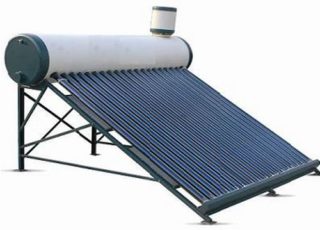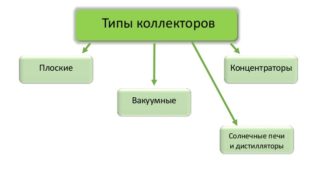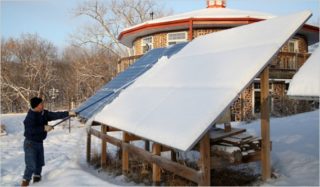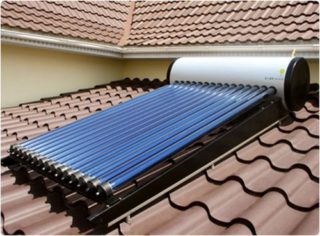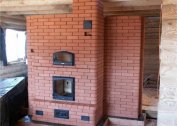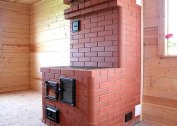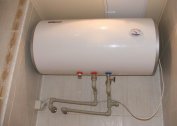Solar heating is the most environmentally friendly way of heating a private home. It is well suited for residents of the central and southern regions of the CIS countries, where the earth's surface receives a sufficient amount of radiation. Using solar heat to heat your home will help save space in your rooms.
Advantages and disadvantages of solar heating
This type of energy is environmentally friendly, its use is accessible to everyone and is not accompanied by emissions of harmful compounds into the environment. The massive use of solar heating systems in a private house will help preserve the natural resources used to heat the room: coal, wood and gas fuel. The use of solar heating structures is completely safe for residents and for the environment. This can not be said about traditional types of fuel - smoke does not have a favorable effect on the atmosphere, it can cause lacrimation and discomfort among others.
To save the usable space of the site, you can install the system on the roof. Mounting such collectors will also help minimize space costs for heating appliances in the room itself. Another advantage - solar panels for the home do not emit any noise during operation.
The disadvantage is that not all areas have climatic conditions suitable for year-round use of solar energy without additional heating. In most regions of Russia in the winter, parallel use of electric heaters or other devices of a similar purpose is necessary. Sometimes the solar system is connected only for operation in seasons characterized by sufficient illumination, in the dark periods other heat generators are used.
Features of solar collectors
Collectors differ from other types of heating systems in relation to the supply of solar energy. As a result of this, the accumulation of heat in the installation stops at night, but the return to the air of the home accumulated during the daytime continues. The effectiveness of the system is determined by the duration of daylight hours. In the warm season and in the southern latitudes, the use of this kind of heating shows the best results. It is the least productive in December, at the darkest time of the day. This is due to the short daylight hours and the angle of incidence of the rays. When calculating the contribution of the solar system to the overall heat supply of the home, it must be borne in mind that its effectiveness varies throughout the year. For winter heating in most regions, electrical appliances, a stove or a boiler are needed.
Of great importance are the correct calculation of the area of collector elements needed for house maintenance and the selected installation angle. It is advisable to place the device so that the angle of inclination is equal to the geographical latitude of the locality where the dwelling is located. Best of all, solar energy is absorbed by collectors whose work planes are at right angles to the incident rays. Whenever possible, batteries are placed south. It is important to ensure that shadows cast by buildings or trees do not fall on the surface.
In order for the efficiency of work in winter to be higher, the angle of inclination of the elements should be slightly larger.In the summer, in turn, productivity will be slightly lower, but this should not adversely affect the quality of life of home owners.
Elements of the heating system
There are several types of solar panels, but the principle of the construction of most heating systems based on them is identical. Sometimes additional components may be added to the configuration.
The main elements of the installation:
- vacuum manifolds;
- a controller responsible for managing the system;
- battery tank for heated water;
- a pump carrying the coolant from the battery to the battery;
- TEN working from an electric network.
Instead of the heater, another detail can also act as a closer. Sometimes such a heating system is combined with a floor heating device.
Types of Solar Collectors
Collector elements are available in several versions of the device. There are models designed only for heating purposes and additionally heating water.
By design and appearance
Collector devices are available in open form (with unprotected tubes) and in closed form with active components sealed in a housing that can have different designs, for example, flattened or spherical. The cheapest and most durable are flat enclosed models. Their body is made of aluminum, inside are placed pipes made of copper. They can be mounted in serpentine or parallel rows. Gas, water or non-freezing liquid can circulate through them, acting as a coolant. On top of the case is a coating consisting of glass and propylene glycol layers. Such models can work year-round, heat water to a temperature 30-40 degrees higher than air. But they have a significant drawback: if the collector breaks, the entire heat absorption system fails.
Vacuum products are the most powerful. They also contain copper tubes filled with heat absorber, arranged in rows. Each such element is placed in a glass cone. The vacuum space between the walls plays the role of a conductive material and a heat insulator. The weakness of this design is the fragility of hollow glass elements. On the other hand, in case of failure, it is enough to directly replace the damaged tubes here.
If the contribution of the solar system to winter time is important, it is better to connect vacuum collectors. They retain heat longer and warm gases and liquids to higher temperatures. It is possible to assemble the structure directly on the roof of the house. The tubular shape allows you to collect heat during daylight hours without connecting additional mechanisms that monitor the movement of the sun.
According to the principle of work
This criterion describes the collector elements in terms of autonomy. Some types do not need electricity. This makes them a good option for a country house or operation for a certain season. Devices with a forced circulation mechanism must be connected to the mains before use. They function due to the pressure of the pump mechanism.
By seasonality
Some consumers prefer connecting solar panels only during the warmer months. In collectors, designed strictly for this form of operation, water acts as a coolant. At temperatures below zero, it turns into ice, so with the onset of cold weather such plants are dismantled. Other models allow year-round use. In the warm season, they are able to provide consumers with hot water, and in the cold - they maintain air temperature at a certain level.
DIY collector making
When purchasing a ready-made kit, the scheme for connecting solar panels is usually indicated in the attached documentation. But some residents prefer to assemble a home-made collector at home. A simple unit is made from improvised materials using a serpentine structure removed from an obsolete or broken refrigerator as the basis.
To make a collector, you need to cook:
- foil and glass sheet;
- coil from the refrigerator (you can also dismantle the connecting clamps from it and use them in the new unit);
- rack elements for creating a frame;
- tape tape;
- fasteners - screws and screws;
- rubber mat;
- fluid tank;
- supply and drain pipes.
The coil is first washed from dirt, dust and traces of Freon, and then wiped dry. The slats are cut under the dimensions of the serpentine structure from such a calculation that it fits into the frame mounted from them. Then you need to connect the rails to each other. A carpet of rubber should match the size of the frame. If necessary, cut off the excess. In the process of connecting the rails, you need to make small holes in the walls so that the coil tubes pass if they need to be removed.
The mat is covered with a layer of foil. If you have to use small-sized cuts for coating, they are connected with tape. Then lay the rack structure, and after - the coil, which is fixed with clamps. The latter should be fixed on the opposite side with screws. From it, the rails are nailed so that the configuration becomes tougher.
If gaps are found between the slats and the foil, they are supposed to be sealed with tape. This will minimize heat loss and increase the efficiency of the finished installation. When the unit is ready, a glass coating is placed on it. Then gluing is carried out with adhesive tape around the entire perimeter of the product.
To make the collector as tight as possible, the glass is strengthened with screws. It will also make the device more reliable. After that, the resulting element can be strengthened on the supporting structure.
The principle of the system
To use the energy of the sun as efficiently as possible, you can act in different ways. The principle of the first is based on the direct heating of the collector elements by the rays of the sun. Accumulating heat, the devices transfer it to the liquid coolant located in the heating and hot water supply circuits. A resource can be spent on the implementation of both of these goals, or only one. The action of the second method is based on the introduction of solar panels into the heating system, converting the stored energy into electricity, which is then transmitted to the consumer.
When using a device made of a coil, in sunny weather, you can heat water to 60-65 degrees. At the same time, the system is autonomous, the coolant in it circulates naturally, homeowners have to intervene infrequently. The movement cycle looks like this: the heated liquid becomes less dense, due to which it rushes up - into the prepared container (for example, a tank). Dense cold water is directed to the lower area of the collector. In addition to the tank, several pipes are required for mounting the system. Heated water is supplied and drained and cold enters the collector. 4 valves are also needed: drain, shut-off, recharge, relieve pressure in the system.
It is advisable to dismantle water collectors in winter, since this coolant tends to freeze, which makes operation useless. Models that are designed for year-round use require regular cleaning of adhering snow. The latter has the ability to reflect the rays of the sun, which seriously reduces the efficiency of the collector.
Solar heating systems can be connected not only in the southern regions, but also in areas characterized by a temperate climate. Even with a small number of sunny days in cold seasons, ultraviolet radiation coming through the clouds can at least partially warm the home. In this case, you can’t do without additional heating devices, but the environmentally friendly work and the free energy resource make these installations an excellent choice for private homes.
